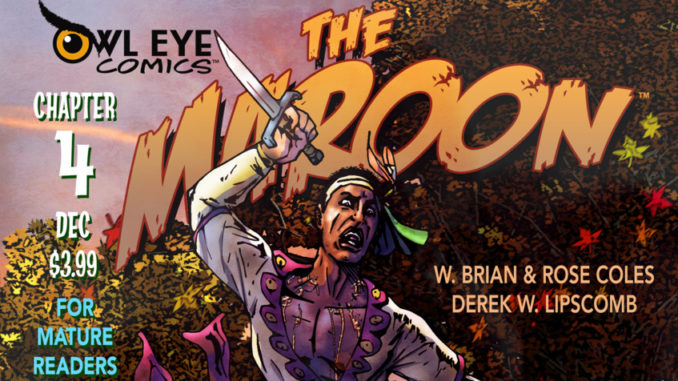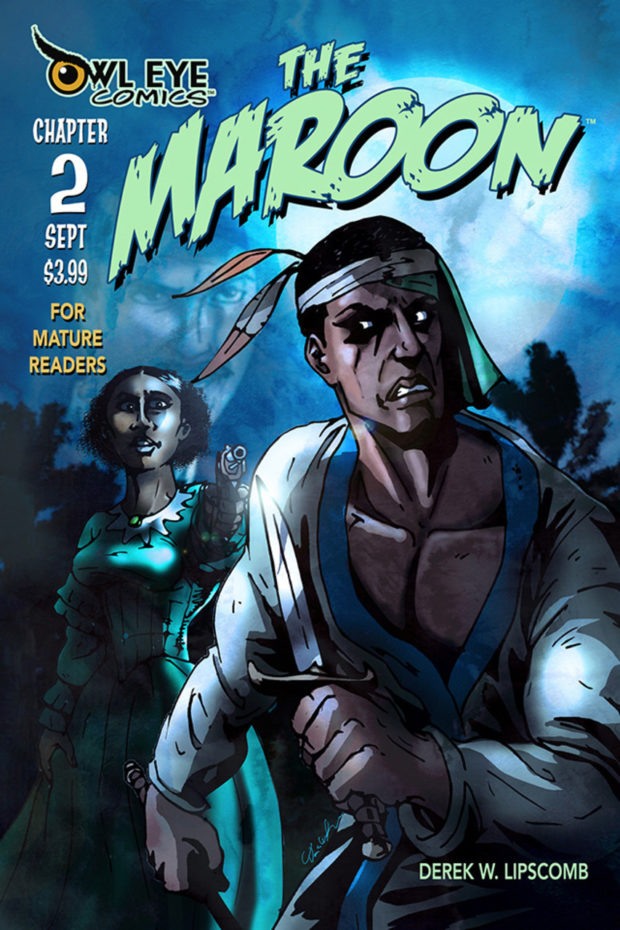
 Historical fiction works best when the writer is not afraid to confront the uncomfortable truths of the past. Slavery in the United States existed. Black people were stolen from their native homelands and were forced into laboring for free. In a new world, where they experienced life with people who did not share their language or beliefs, those who survived adapted to a new way of life. In 1850 this particular Seminole, black man, The Maroon has had a long journey. Though he’s imbued with supernatural strength and has leaned on his skills as a hunter, he is still a dark-skinned man living in the antebellum south. Constantly being hunted can tear at your soul and creator and writer Derek W. Lipscomb has an ending to ‘The Maroon’ storyline arc that will leave you with a whole set of feelings you won’t know what to do with.
Historical fiction works best when the writer is not afraid to confront the uncomfortable truths of the past. Slavery in the United States existed. Black people were stolen from their native homelands and were forced into laboring for free. In a new world, where they experienced life with people who did not share their language or beliefs, those who survived adapted to a new way of life. In 1850 this particular Seminole, black man, The Maroon has had a long journey. Though he’s imbued with supernatural strength and has leaned on his skills as a hunter, he is still a dark-skinned man living in the antebellum south. Constantly being hunted can tear at your soul and creator and writer Derek W. Lipscomb has an ending to ‘The Maroon’ storyline arc that will leave you with a whole set of feelings you won’t know what to do with.
Being on the run for so long means that you make mistakes. Sometimes they’re shaped from a myopic point of view, which can be detrimental. In earlier issues, the protagonist nearly loses his life to a shapeshifter. In this culminating issue, the Maroon believes he has the right target. However, he does not take into account that the evil aspects of a shapeshifter may come in a non-threatening form and makes a rookie mistake. Thus endangering the lives of the people he’s attempting to save. In a sense, the Maroon with all his abilities and knowledge is reminding the audience that he’s not infallible. Even with his frailties, we see the legacy of slavery in the hunting down of runaways and the economics behind patrollers. In pitting poor whites and slaves against each other, there remained a status quo that perpetuated slavery. This racist institution that dehumanizes one set of people, leads to a false sense of a stable society. ‘The Maroon’ shows how no one is left unscathed in a place where people are treated like chattel. Inevitably the hunters become the hunted until no one is left alive.
The violence, by the way, is necessarily savage. Throughout the six issues, the realistic, mature narrative has been matched with the intensity of the artwork. When witches transform into owls with huge eagle wings, the imagery is fascinatingly scary. Likewise, the ingenuity of how an ax is used emphasizes the mature audience layer of the story. When you’re dealing with the evils of slavery, the visual intensity has to match the story and it does its job here. Also, consider how these characters are illustrated. When the Maroon is confronted by the man he must join forces with, the anger, frustration and in the Maroon’s case remorse are shown all over the faces and posture of these men. One a slave, one born free don’t seem to realize that they are in the same predicament. Eventually, in this comic when you’re black, you end up running for your life.
Still, if you’ve been riding with ‘The Maroon’ for the past six installments of this comic book series, the payoff is in sight. Readers will finally get to understand why even when he kills by necessity, the Maroon’s heavy-handedness is extreme in its force. Folklore and mysticism combine to show the Maroon why he cannot remember his past. But do you trust the very one who has been purposely deceiving you?
Overall, the ending of this storyline arc leads to another as the Maroon figures out who he is and attempts to take control of his own destiny. In the meantime, another loose end lingers in the epilogue of this satisfying story. There’s much more to discover of ‘The Maroon.’

Leave a Reply